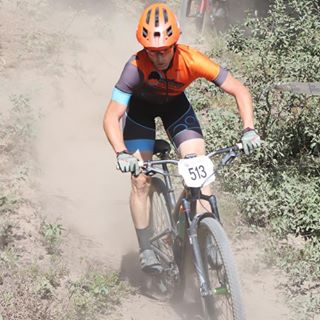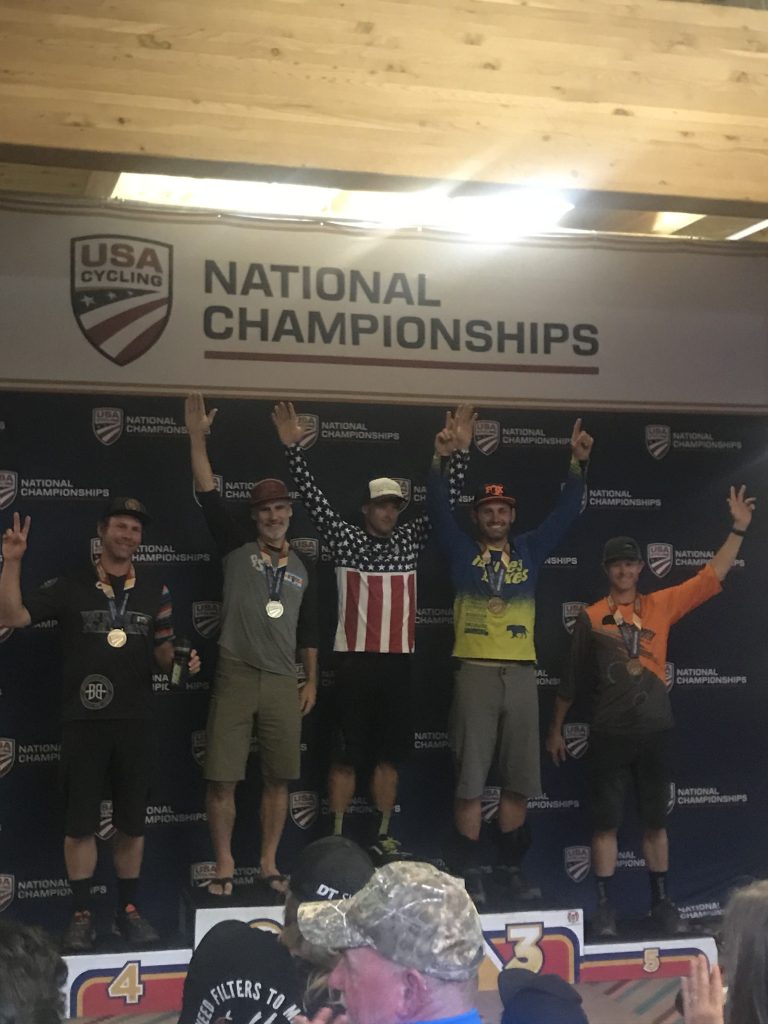MTB National Championships – Winter Park, Colorado
Final lap, final rooty climb, bang out >500 watt effort while enduring cramps to pass a podium rider in the age group that started ahead of me. Breathe.
Drop in the last rocky chute fast and composed. Breathe.
Carve from trail onto the start/finish stretch. Finish line in site 300 meters! Breathe.
Cranking good power seeing >400 watts in spite of the cramps! Breathe.
Hear the announcer yelling “Look at this sprint!” as I was mere 25 meters from the line. Gasp!
Someones coming! What?! So I made an uncoordinated attempt to glance back & stomp on the pedals simultaneously with a 750w effort from seated, but it wasn’t enough to hold off Kevin Bradford-Parish from nipping me at the line and edging me off the podium!

Albeit he is a well-decorated multi-time national champ, a fighter, great bike handler, and all-around good dude, so no-one I rather that podium spot to, but it was still tough to swallow. And how?
I let it happen. I did initially look back after the pass and only saw Mike that I’d just passed but I embraced my “eyes forward” approach to focus on what I thought I should be and that was finishing strong. What I didn’t account for was the sound I heard wasn’t Mike behind me, but the savvy racer Kevin had used Mike to slingshot past and was coming for me. Or more correctly that podium spot. Which he secured by that 1 second over that 100 minute race covering 20.5 mile!
In that moment, I felt like I’d lost!
But had I lost? Upon reflecting I’d argue, I’d still actually won!
Wait, what?! You may ask, “how can you go from getting pimped off the podium to calling it a win?”
The answer lies in what you defined as your win for the day. And for me, competing for that podium wasn’t even where I’d expected to be that day. That doesn’t mean undershoot your goals and aspirations so you can inflate a subpar result. It just means being realistic with your preparations and current ability. And I knew that I hadn’t put in the work to be as competitive as I’d like.
I need to circle back to why this was a win and be clear I’m defining it as a figurative win and not literal. Because I don’t want to degrade what the literal win signifies and requires to those that did. I know what it takes and what it feels like as I pulled on that stars and stripes jersey for a previous marathon mtb as well as 24 hour national champs and I wrote on the mindset that required here. I hadn’t put in that commitment or intent this year.
I figuratively won because I raced up-to, if not above, my potential. This includes my preparation and expectations set on that day! There is objective data on top of these subjective points at the end of this article below, if you care to see. But for now, let’s go through some objective variables known in-advance of toeing the line that were a glaring reality staring me in the face.
This event wasn’t even “confirmed” on my calendar or radar the entire year, but more of a last minute, “made it work”. So I wasn’t specifically preparing for it.
I knew my FTP was lower than previously attained.
I knew I wasn’t just there racing but coaching & supporting athletes. I had already completed a half-day of demanding runs on the DH course as part of a skills camp as well as previewed some enduro stages.
I wasn’t just there to race XC but also Enduro as well so I was splitting between the events and had ridden 20 miles of enduro stage scouting that morning of the x-country race.
Once I started there were some variables that were apparent as well. I started having calf cramps on the 1st climb of the 1st lap!!!! I can say I can’t remember if I’ve ever had calf cramps, but I sure did this day. I credit that to the DH and Enduro runs enduring all the braking bumps, sending jumps and resultant eccentric soaking-up of terrain. So when I felt this in lap 1 of 4, it took a lot of tenacity to focus, put it behind me, and keep on the gas.
How did I do that? Honestly that was rather simple when the real-time dynamic transitioned from “not being in the mix” to “racing for podium” fueled that competitive fire.
I started conservative and wasn’t overly aggressive, only in the top 10-12 places on 1st climb. I started to pick off people before the 1st descent. Moved up on the descent. Then repeated this process on lap 2 and again by lap 3. And I know I raced up to my potential because the previous year, I’d raced on my 130/150mm travel bike (it’s all I had with supply chain limitations) and set a fast time on singletrack descent on the course. But this year I was on a hardtail (not by choice as again, still didn’t have a suspension XC bike), which meant I could climb a bit lighter, but also likely to give up some time on the descent. But I managed to connect with an old racing buddy Macky Franklin that was absolutely killing the SingleSpeed race and on a hardtail and I thought, “Well I know he can descent….annnnnd he’s on a hardtail, then so should I.” So I latched on and managed to pucker a new PR on that lap and end with a shit-eating grin putting me farther up in the mix and in a great mind frame as well as higher placement. I found myself within striking distance of the podium, so I made the connection and the pass even while enduring cramps that had migrated from my calves now to both my quads and inner adductors.
All this said, I went from lining up thinking a top 10-15 placement would have been a good day to racing onto the podium and just missing it by 1 second. How could you not quantify that as a win on the day?
 And to make it more of a win, the overall goal of the entire national championship event began to accumulate. The athlete I coached the DH runs with made the podium and another athlete added another DH national jersey to his palmares. A day later I managed to podium in the Enduro. And to boot I rode nearly all day of the Enduro with Kevin,the rider that had beaten me at the line yesterday enjoying the camaraderie of competition and the transfers and ended up finishing 14 seconds ahead of him over the course of 5 race runs and nipping him off the podium. So it all evens out!
And to make it more of a win, the overall goal of the entire national championship event began to accumulate. The athlete I coached the DH runs with made the podium and another athlete added another DH national jersey to his palmares. A day later I managed to podium in the Enduro. And to boot I rode nearly all day of the Enduro with Kevin,the rider that had beaten me at the line yesterday enjoying the camaraderie of competition and the transfers and ended up finishing 14 seconds ahead of him over the course of 5 race runs and nipping him off the podium. So it all evens out!
I may have been nipped off the podium and yet I still Won!? That is how you frame a Win when most see it as a loss and allow it to serve you with positive motivation versus drag you down psychologically!
And if you want to see some data with a bit of comparison for the 3 years of Winter Park, Cross Country national championships, here is a discussion with accompanying comparison chart. Enjoy!
I quantify this from a mix of both data as well as some subjective variables. The data I have from actual finish time, power, heart rate, percent of current FTP, MMP, etc. See Table 1 for the 3 years on the same course. The Lap times vary from racing tactics and some small changes of start venue routing, but that came down to how I approached and raced the race. A few things worth noting are how relatively close the finish times, lap times, Mean Max Power (MMP), Normalized power (NP) and Avg power. But what differs is the IF or Intensity factor highlighted yellow. This is basically a metric relative to % of FTP. So you can see for 2022 I raced at nearly 98% of my FTP for 101min vs the previous year, 93% and 95% in 2019. 
These IF values are all very high and basically all represent racing above what I’d say as a normal capacity for most athletes. It’s kinda a 2-fold mythbuster since it’s usually highly unlikely to ride at that high of a % over FTP for that long AND especially when the event is at higher altitude (>9,000ft/2800m).
This is why I always joke, I’m a better competitor/racer than a trainer. The 1st part I can kinda explain since I’ve improved my TTE (time to exhaustion), which is basically how long you can sustain your FTP. I’ve pushed mine out >75 min so that means with the dynamic of mtb with some intermittent breaks then it’s more feasible to hold that high of a percentage. Also the stochastic nature of mtb requires many supra-threshold efforts with mandatory descents or turns which can result in a falsely elevated Normalized Power.
The other variables that are sometimes subjective are Heart Rate values and the resultant Power:Heart Rate (cardiac drift) figure. These avgHR and peakHR values vary some and this is also based on how the race played out. Some efforts prime the system and keep the HR elevated from then on as you can’t really intentionally recover. For example, in 2019 I decided to race aggressively and take the lead on a lap and that likely blew me up as I couldn’t keep pace when others ramped it up in later laps. Hence my Pwr:HR being flat at 2% because HR was high the entire time. Whereas in later 2021 and 2022, I wasn’t feeling competitive so I decided to let the race go up the trail and just ride my race. But once I realized I’d raced into the podium mix, I pushed harder and thus caused more cardiac drift. But the difference of 7.1% in 2021 vs 6.5% in 2022 was the cramps, as they limited my ability to push and thus keep HR pinned all the way to the end.